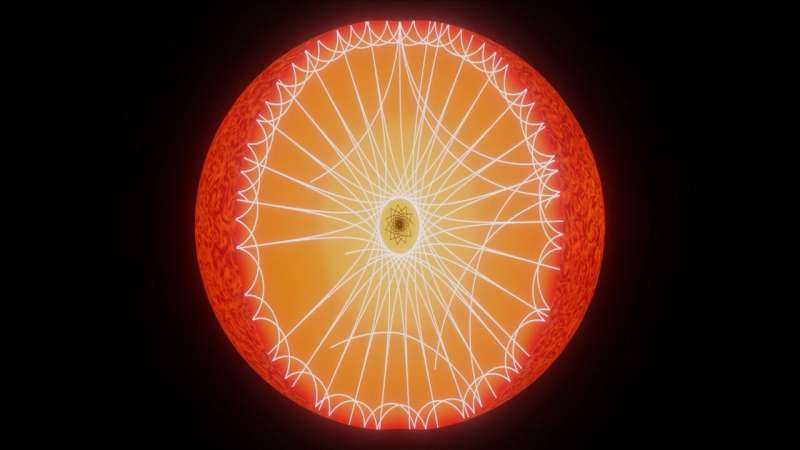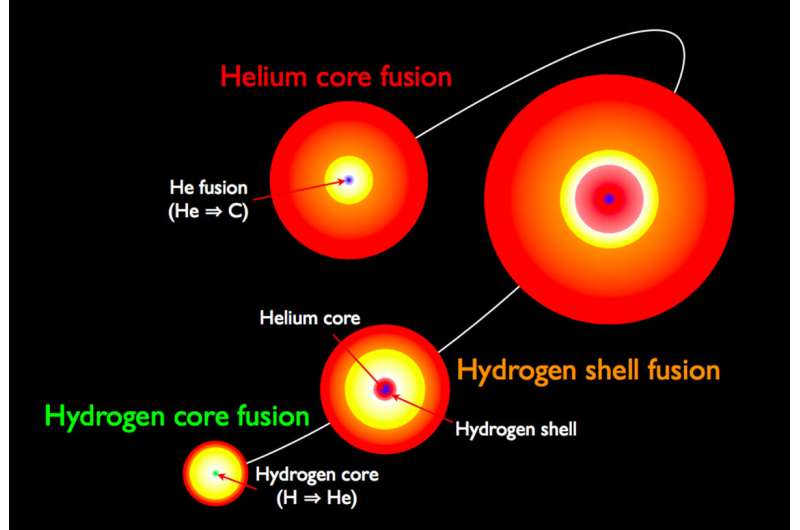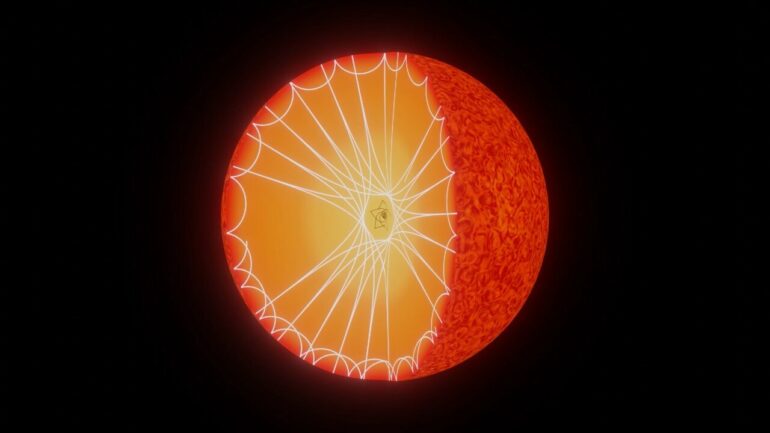Red giants are dying stars, in advanced stages of stellar evolution, which have depleted the hydrogen in their cores. In a study published today in Nature Communications, a team of astronomers mainly from Instituto de Astrofísica e Ciências do Espaço (IA), have found new evidence that red giant stars experience “glitches”—sharp structural variations—in their inner core.
Unfortunately, it is impossible to look directly inside a star. However, a technique dubbed asteroseismology, which measures oscillations similar to “earthquakes” in stars, can provide indirect glimpses of stellar interiors. The “glitches” can affect these oscillations, or the frequencies and paths of gravity and sound waves traveling through the stellar interior.
As IA researcher Margarida Cunha explains, “Waves propagating inside stars induce minute stellar brightness variations that can be detected with highly precise space-based instruments. These waves reveal the conditions of the medium where they propagate, which is to say, the physical properties of the stellar interiors.”
The team used data from the Kepler space telescope (NASA) to detect and study waves propagating to the deepest layers of evolved stars.
Lead author Mathieu Vrard, currently a postdoctoral research associate in astronomy at the Ohio State University, explains, “This work presents the first characterization of structural discontinuities present in the core of red-giant stars, therefore allowing, for the first time, to precisely sound the physical processes occurring in this region.”
Vrard, who began this work at IA, adds, “By analyzing these variations, we can obtain not only the global parameters of the star, but also information on the precise structure of these objects.”

Artist’s impression of waves, with different frequencies, travelling in the inner layers of a star. P-modes, or pure sound (pressure) waves, in white, spend most of their time in the outer envelope and are directly visible at the stars’ surface. G-modes, or pure gravity waves, in black, propagate in the radiative interior and hold information on the stellar core. In red giants, the two are coupled together and the resulting waves sense all layers, thus revealing information of the stars’ deepest interior. © Tania Cunha (Planetário do Porto – Centro Ciência Viva)/Instituto de Astrofísica e Ciências do Espaço
Low-mass red giants experiencing helium burning in their cores are often used in astrophysical studies as probes of distance, to measure aspects like galaxy density, and to learn more about the physical processes behind stellar chemical evolution. So it’s vital that scientists model them correctly which, in turn, requires that they understand why these discontinuities happen.
In this work, the team analyzed a sample of 359 red giants that were below a certain stellar mass, measuring various properties and individual oscillation frequencies of each star. They discovered that almost 7% of these stars exhibit structural discontinuities.

Schematic of the evolution of a main sequence star, to red giant. The stars in this study are at the end of the evolution track shown, experiencing helium core fusion. The different evolutionary stages are not to scale. © Thomas Kallinger, University of British Columbia and University of Vienna
There are two main theories which explain how these disturbances might work. The first states that “glitches” are present throughout the star’s evolution, but are generally very weak and below the threshold for what astronomers would categorize as a true discontinuity.
The second suggests that these irregularities are “smoothed out” by some unknown physical process that later leads to changes in the structure of the star’s core.
As it turns out, the first scenario is not supported by this study, but more precise data is needed before scientists can confidently subscribe to the second. Diego Bossini (IA) explains, “This study shows the limits of our models and it gives us an opportunity to find a way for improving them.”
More information:
Mathieu Vrard et al, Evidence of structural discontinuities in the inner core of red-giant stars, Nature Communications (2022). DOI: 10.1038/s41467-022-34986-z
Provided by
Institute of Astrophysics and Space Sciences
Citation:
Astronomers discover irregularities in the cores of red giants (2022, December 16)



